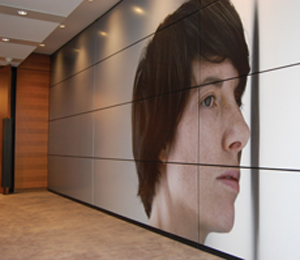When one of Guido Molinari’s trademark abstract artworks arrived at Torys LLP in the late 1980s, it almost sparked a riot - or as close as you can get to one in a Bay Street law office.

“It’s one painting that the managing partner at the time did want to send back,” says Philip Mohtadi, a member of the firm’s art committee, which has administered the Torys collection since it started seriously amassing works around 30 years ago.
From a distance, Red Quantifier 7 looks extremely basic, like a solid red rectangle. “It received a fair amount of scorn and criticism because it is so simple,” Mohtadi says. “And then there was the inevitable ‘My child could do that.’”
But up close, you can see clear dividing lines as the texture and shade of the paint vary subtly across the canvas. The art committee held firm by overruling the managing partner. The work now occupies a prime spot on the 33rd floor of the TD Centre on Wellington Street near the firm’s reception.
Around the corner, another of the firm’s most controversial pieces, Garbage Bag by Vancouver artist Kelly Wood, anchors one end of the central corridor that bisects the entire floor.
The imposing piece stands virtually from floor to ceiling, demanding attention from any point along the corridor. A decade after the infamous Molinari purchase, it threatened to provoke another serious assault on the art committee’s independence.
“A lot of people didn’t like it because they thought it reflected badly on the firm that somehow this was a comment on the work product or the lawyers,” Mohtadi explains. “It’s obviously not just about garbage, although that’s what inspired it. It’s about collecting, recycling, and looking into things.”
The group’s commitment to contemporary Canadian art hasn’t always gone down well at a firm whose very name evokes conservatism. “Contemporary art is not everyone’s cup of tea,” Mohtadi says. “People have a particular idea about art and what appeals to them.”
But over time, many lawyers have come around, to the point where the most controversial purchases are now centrepieces of the collection.
“Some things we have in the collection would have been intensely disliked or misunderstood at first, but it’s all part of the fun of understanding art and appreciating it,” Mohtadi says. “Like a lot of other things, you have to give it time.”
For those of a more traditional disposition, the Jim Baillie room, named after a senior lawyer at the firm, features some Group of Seven works and several pieces donated by Baillie himself.
Five years ago, when the firm’s most recent renovation began, Marianne McKenna, a founding partner at KPMB Architects who was in charge of the project, wanted to make sure the changes reflected the firm’s long commitment to its art collection. “My recommendation was to hang it on the art and make a space that takes art really well,” she says.
Torys also took the opportunity to commission two new unusual works. The move came after McKenna saw another firm mounting art on the removable divider walls that split up huge conference rooms into smaller meeting spaces.
“They had done it in a very minimal way,” she says. “My thought was if we’re going to do this, let’s just do the whole wall. Go big or go home. I’m not embarrassed to use a good idea, but let’s just do it in a more powerful way.”
As a result, the firm selected two artists to design art that would fill the walls of the rooms on the north and south sides of the building.
Inspired by Lake Ontario, Toronto artist Robert Fones superimposed a passage from Don Quixote on top of images of the water, while Pascal Grandmaison of Montreal filled each of his walls with a pensive face photographed from different angles.
“It’s about the serious decision-making process that lawyers go through on a daily basis,” McKenna says.
The walls then fold up into the ceiling, leaving a thin strip of the artist’s work visible even when they’re not in use.
The logistics of the project meant the artists were unable to see the final work until after they were installed in the conference rooms.
“We actually got to see the work before the artists,” Mohtadi says. “Nobody really knew how it was going to turn out because we hadn’t done anything like it, but they were happy and surprised at how well it worked.”
This is the third instalment in the Law Times summer series looking at law firms’ art collections. Click here to watch the video of Torys partner Phil Mohtadi discussing the firm's contemporary, and sometimes
controversial, collection.
For more in the series, see "Why do lawyers love art?"

 “It’s one painting that the managing partner at the time did want to send back,” says Philip Mohtadi, a member of the firm’s art committee, which has administered the Torys collection since it started seriously amassing works around 30 years ago.
“It’s one painting that the managing partner at the time did want to send back,” says Philip Mohtadi, a member of the firm’s art committee, which has administered the Torys collection since it started seriously amassing works around 30 years ago.